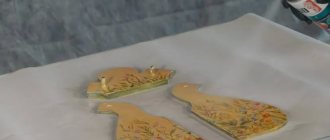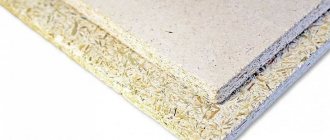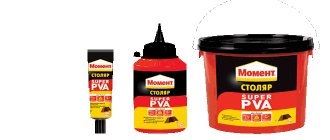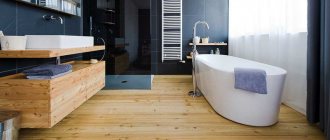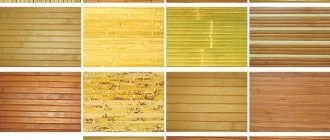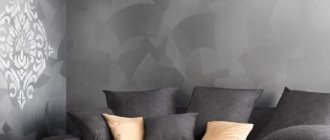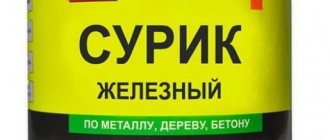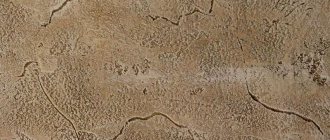In the production of oil paints, natural drying oils are used as a film-forming substance, the basis for which are vegetable oils, such as hemp, soybean, rapeseed, cotton, linseed and others. In the production of alkyd paints, the film-forming substance is alkyd drying oil, prepared on the basis of a solution of pentaphthalic or glyphthalic oil-containing oligomer resin in organic solvents. Alkyd paint is successfully used indoors and outdoors, covering materials such as metal, wood, and brickwork.
What is the difference between oil paint and enamel: comparison table
June 21, 2021
Read later
We will send the material by email
When performing finishing work inside or outside a building, various coloring agents are often used. They are simply irreplaceable when decorating ceilings, walls, and floors. Paints are also used in the production process and restoration of furniture and interior elements. In order to obtain the expected effect after painting the surface, and in order for the created coating to subsequently withstand external mechanical loads well, it is necessary to choose the right coloring composition. The modern market offers a huge range of paint and varnish products. Therefore, it is worth understanding the characteristics of the main types of such products and paying attention to their pros and cons. This will help you purchase the most suitable option for yourself and save a lot of money.
In the process of carrying out repair or finishing work, coloring agents of different compositions are almost always used Source hotel-a.ru
Alkyd paint characteristics
Solvent-based paints and varnishes contain a volatile organic solvent that evaporates during the drying process. Currently, the only solvent that can be used in all countries of the world without any restrictions is white spirit (purified kerosene).
When working with organosoluble products, certain precautions must be observed. When applying them to large surfaces indoors or in a small confined space, it is necessary to use special personal protective equipment.
Water
Water-based dyes are mixtures that, if necessary, are easily dissolved with ordinary water. Their drying occurs due to intense evaporation of water, as a result of which film-forming substances create a long-term, integral coating.
Such paints can contain completely different fillers: acrylic, silicate, cement, latex. Among the features of these compositions, it is worth highlighting the following:
- They are most often used for interior finishing work, since under the influence of the natural environment the coating they create quickly collapses.
- They interact well with all kinds of finishing materials: they can be applied to wooden bases, rough finishes, wallpaper, and various wall panels.
- Finishes made with water-based paint are breathable. Thanks to it, a comfortable microclimate is formed in the room, and there are practically no problems with fungi, mold, or air stagnation that are dangerous to health.
- They are characterized by a high drying speed: one layer sets in approximately ten minutes to two hours. The latter depends on the filler.
- They can be used in rooms with different levels of lighting, since they do not fade under the influence of ultraviolet radiation and retain their original color for up to twenty years.
- A coating properly created with water-based paint retains its integrity and does not peel off.
- The base shade of water-based paints is white. But if you add the appropriate color pigment to them, you can easily get any color. The latter allows you to realize all kinds of artistic ideas in the process of interior design.
Important! Since water-based dyes do not contain organic solvents at all, they do not have a strong odor and are considered safer and more environmentally friendly than any other types of similar substances.
Water-based compositions are extremely in demand because they are environmentally friendly, safe for health, and easy to work with even without the appropriate skills Source vmirekraski.ru
Drying oil
Drying oil is a film-forming substance made by heat treatment of vegetable oils (linseed, sunflower or soybean). Based on the amount of oil in drying oil, it is divided into natural, oxol, combined, alkyd and synthetic. According to Russian GOST, the oil content in natural drying oil should not be less than 97%, the remaining 3% is occupied by drier - substances that accelerate the drying process of paint. Using more dryers has a detrimental effect on the paint, causing it to oxidize. As a result, the paint may darken and the coating may become brittle. Natural drying oil is a dark brown oily liquid that is practically odorless. Natural drying oil paints are more expensive than other types of oil paints.
Oily
They are always produced strictly in accordance with GOST. They always contain drying oil; it can be of plant or synthetic origin.
Kinds
Based on the method of application, the following oil paints are distinguished by consistency:
- Thickly grated. To bring such material to the thickness required for use, drying oil or turpentine should be mixed into it. The solvent is selected depending on what texture you want to achieve in the end: the first product helps to form an attractive glossy surface, the second - a matte one.
- Liquid grated. Completely ready for application, they do not need to be diluted or prepared by any other method.
The most important advantages of using oil paints in repairs are a wide selection and low price Source stroymag.dp.ua
Oil paints have both positive and negative properties. Among their main advantages, it is worth highlighting the following:
- can be applied in various ways: roller, spray gun, regular brush;
- affordable price;
- huge selection of shades;
- long service life of the created coating.
Flaws:
- they lose a little in effectiveness when compared with other modern solutions;
- painted bases take too long to dry;
- cannot be applied in a thick layer;
- toxic;
- have a strong unpleasant odor.
Important! Coatings created with oil paint turn yellow over time and lose their original attractive gloss. Moreover, this happens regardless of operating conditions.
Oil paints are intended for painting external and internal surfaces, metal products, natural wood Source otdelka-expert.ru
Combined drying oils
Combined drying oils are a combination of drying oil, solvent and drying agents in various proportions. Most often, the solvent content does not exceed 30%. There are also synthetic drying oils, which contain only petroleum products and solvents.
Their only advantage is their low price, and the list of disadvantages is extensive: the paint applies unevenly, has an extremely unpleasant strong odor (even compared to other types of oil paints), takes a very long time to dry, crumbles and cannot be repainted with another paint.
Enamel
It has a very thick consistency. After its application, a fairly smooth coating with a beautiful glossy shine is formed, resistant to external chemical and mechanical influences. Enamel is produced on the basis of varnish; it also contains zinc oxide and other additional substances. Depending on the binding component, there are several types of such paint.
Acrylic
Today it is considered the most popular and in demand among users. This is easily explained by its following characteristics:
- It can be either transparent or multi-colored;
- resistant to fading;
- short drying period - up to two hours;
- suitable for any materials, perfectly protects metal from rust;
- environmentally friendly;
- The created coating “breathes” well.
Important! Acrylic enamel is perfect for external and internal finishing work. At the same time, it fully retains its beneficial properties and is extremely resistant to any adverse effects.
Acrylic enamel is suitable for painting metal in conditions of high humidity or constant heating Source oxidom.com
Alkyd
It is made on the basis of alkyd resins, alcohols, polybasic acids, which have undergone preliminary heat treatment. This composition determines its main characteristics:
- dries quickly;
- resistant to variable humidity and temperature, various chemicals;
- affordable (cheaper than the popular acrylic);
- easy and quick to apply with a roller.
In its liquid state, alkyd paint has a specific, rather pungent odor. This should be taken into account before starting finishing work.
Alkyd enamel can be matte, glossy and even semi-matte, therefore the scope of application of this type of paint is almost limitless Source kraski-net.ru
Nitroenamel
It is produced on the basis of cellulose pre-treated with nitric acid. Because of this, in liquid form it emits a pungent odor of acetone. Among the useful characteristics of this composition it is worth noting:
- sets quickly (within half an hour);
- inexpensive;
- economical (the solution is applied in a thin layer);
- the coating is perfectly smooth and glossy;
- fits perfectly on various materials;
- can be used for external and internal finishing works.
Important! Since nitro enamel dries out too quickly, it is recommended to apply it with a spray bottle.
The main disadvantages of nitro paints are fire hazard and toxicity, therefore you should work with such compositions only outdoors or in well-ventilated areas Source krasdom.by
Criterias of choice
When purchasing alkyd paint, take into account the material on which it is applied. You also need to be guided by other parameters, taking into account the markings on the banks. The most popular classification is by digital code :
- 0 – the mixture is used as a primer;
- 1 – for external painting;
- 2 – for internal painting;
- 3 – for marking or temporary painting;
- 4 – compositions resistant to water;
- 5 – for rooms with insects and rodents;
- 6 – can be used in contact with oil and gasoline;
- 7 – substances resistant to chemicals;
- 8 – heat-resistant paints;
- 9 – compositions with electrical insulating properties.
There is another method of marking tasks:
- NC – quick-drying coatings with nitrocellulose additives;
- HS – products with anti-corrosion properties for metals;
- GF – paints with glypthal additives;
- PF – pentaphthalic mixtures;
- KO – paints for exterior use, resistant to heat and atmospheric influences;
- FA – moisture-resistant paints on an oil-phenolic basis.
Manufacturers almost always indicate the purpose and application features of their products.
Valera
The voice of the construction guru
Ask a Question
It is not advisable to use alkyd paints for wood, metal and other surfaces with other materials. This is due to different indicators of absorption, expansion and adhesion, as well as vapor permeability.
comparison table
| Characteristic | Oil paint | Enamel |
| The basis | Drying oil | Varnish |
| What can be applied | Spray gun, brush, roller | Spray gun, brush, roller |
| Smell | Less harsh | Cutting |
| As indicated on the packaging | MA | PF |
| Life time | 5 years | 10 years |
| Coating hardness | Below | Higher |
| Changing Hue | Burns out in the sun, turns yellow | Lasts a long time |
| Features of long-term storage | Pigment settles | Thickens |
| What materials can it be applied to? | Wood, concrete, metal, plastic | Wood, concrete, metal, plastic |
In terms of quality characteristics - such as the strength of the resulting film, the purity of the resulting color or appearance - alkyd paints are significantly superior to oil paints Source xn—-7sbblyr7aq.xn--p1ai
What is the difference between paint and enamel.
Useful tips
Before deciding for yourself which paint to choose to cover a particular substrate, you should carefully read these valuable recommendations:
- Enamel protects the surface better than various water-based or oil-based paints.
- Before use, any solutions must be thoroughly mixed.
- When combining alkyd and acrylic enamel, it is important to adhere to the following rule: two-component compositions cannot be applied to one-component ones, but on the contrary, it is quite possible.
- After accidental freezing, water-based paints can no longer be used. Therefore, when storing them for a long time, it is extremely important to strictly follow the manufacturer’s recommendations.
- Nitroenamel must not be applied over a coating created using oil paint.
- If stored for too long, the enamel should be diluted with a suitable solvent before use. The quality of the resulting coloring composition will not suffer from this.
If it is difficult to determine which paint is best to purchase for finishing any coating, you should seek advice from an experienced specialist or consultant at a hardware store.
Before use, any coloring agents must be thoroughly and continuously mixed Source profkom64.ru
About paint compatibility
Many people wonder whether it is possible to apply acrylic paint on top of oil paint, and vice versa, enamel on an acrylic base?
Attention! To begin with, it is recommended to coat the surface with epoxy putty.
- It is advisable to apply acrylic paint only to a similar coating;
- You cannot use alkyd and epoxy resins to paint past glossy and varnished bases;
- Any coating can be applied to dispersion and emulsion materials.

